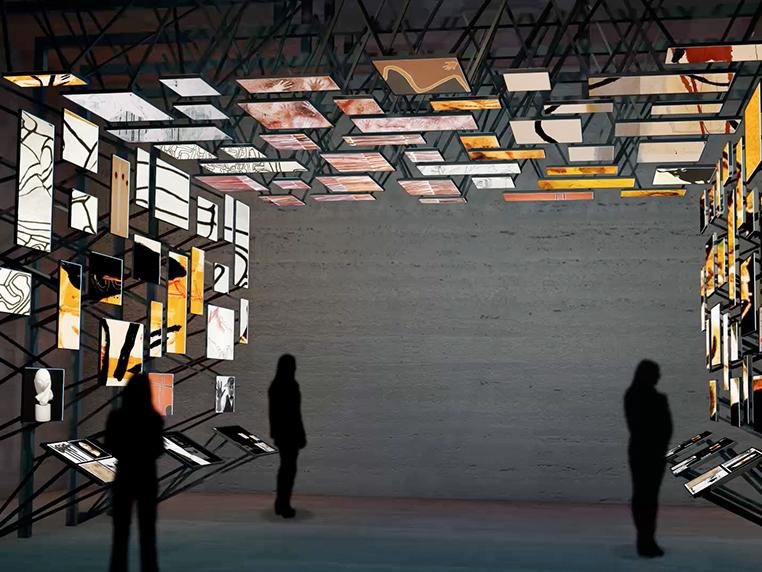Sonovision - Lescaux 4 caves (part 2)
Tuesday8March2016By Annik Hémery
Second and last part of our article on the International Center for Parietal Art in Montignac-Lascaux, known as Lascaux 4, which is scheduled to open in mid-2016.Lascaux in augmented or virtual reality
Offered to adults and children at key points of the visit, the Cdv experiences, equivalent to shows, alternate with those provided by the scenography. Thus, the first contact with the site at the Belvedere is relayed in virtual reality by information broadcast in real time on the visitor's Cdv according to the place to which he is pointing. In the Shelter, the visitor then goes back in time and discovers on a screen, as if through a window, the entrance to the real cave. "When visitors arrive in this room, the landscape projected in real time on this 8-meter-wide screen (two cameras are located outside) is gradually replaced by a film corresponding to the Palaeolithic in the same season (signed by La Prod is in the Pré)”, explains Delphine Rabat.
In the rich interpretation room, the Visiting Companion partially takes over
In front of the Well Scene panel, the Cdv makes it possible to virtually "empty" the ground and replace it with that of the time of the discovery. The objects that appear there, and other vestiges, can then be “grabbed” and manipulated in 3D on the screen. In the same room, the augmented reality application makes the white model of the cave speak. All you have to do is aim at markers with the Cdv to see the fragments of which the room offers a reconstruction appear on the screen. “The Visiting Companion is multifunctional,” sums up Thierry Barbier, in charge of the project at Axyz. It serves both as a digital cartel, to broadcast audiovisuals translated into three languages in addition to the scenography, and to participate in experiences in augmented reality and virtual reality. In the apse of the interpretation area, the Cdv even uses the “Torch” function, revised and corrected Lascaux, which allows you to discover, with black light lighting, the engravings in a sequential way.
An infrastructure based on Watchout V6

Winner of the supply and programming of audiovisual equipment lot, the Atelier du Son et de l'Image (Château-l'Évêque), with Vidémus in co-contracting, chose the Watchout solution (version 6) to manage all video maps of the route. “With version 6, which includes a 3D mapping engine, we can directly integrate the 3D scan of the cave,” notes David Martinet, in charge of studies and technical management of the project. The viewpoint of each projector is calculated automatically. This ensures pixel-perfect positioning of the texture to be projected onto the reproduction shells. Given the very large number of facets to be textured (around a hundred thousand), Vidémus has developed calibration tools in order to arrive at an implementation of approximately half an hour per fragment to be textured. The Watchout distributor (Dataton) was also responsible for automating and synchronizing the shows with Medialon Manager version 6, which provides centralized management of the Center (two audiovisual control rooms), as well as synchronization of the Compagnon de visite with the broadcast media. “Lascaux 4 is a complex project due to the number of actors, video sources (between one hundred and fifty and two hundred), the diversity of projection media, remarks Benoît Dauvergne, project manager at Vidémus. Each zone has specific constraints (calibration of mappings, distribution of very large images, etc.) and complex sequence rules managed by Medialon. In addition to calibration tools, we have developed adapted administration interfaces. »
The large number of broadcasting devices (one hundred and thirty screens, etc.) led the Atelier du Son et l’Image to standardize the stock: “We want a minimum of dormant machines, continues David Martinet. There are also aesthetic constraints: the screens cannot be mismatched or have different panel brightnesses. In the area with ninety screens, we have 46-inch, 32-inch and 24-inch Nec screens. The mechanical interface between our machines and the general structure is designed and manufactured by our departments. To cover all projection issues (power, layout), the integrator chose Christie (Christie Mirage WU 12,000 lumens 3D model) and Panasonic (Panasonic 7,500 lumens, 3,500 lumens full HD laser LED, PT-RZ 475, PT-DZ 780 laser LED). “These machines are equipped with ultra-short lenses and are often positioned directly above surfaces, upside down or on their edges. The fact that they are among the quietest in the range (a request from the tender) also explains the reason for this choice. Finally, it is mainly Bose products that will ensure the sound system of the place (indoors and outdoors). "This is our biggest project (1.5 million euros for the budget of the audiovisual lot, editor's note), believes David Martinet. But it is also the one that is most important to us. The Sound and Image Workshop has equipped most of the major tourist sites in the region such as the Proumeyssac chasm (first sound and light show in 5.1 underground), the International Pole of Prehistory, the Cro-Magnon Shelter …” For Orpheo, which will deliver nearly a thousand Visiting Companions, it is also “the largest order in the history of its company”.
Continuation of an article whose 1st part was published last Tuesday!
You can read the full article in Sonovision #2.
Subscribe to receive the full articles as soon as they are released!



![PAU - [ Altern@tives-P@loises ] PAU - [ Altern@tives-P@loises ]](http://website-google-hk.oss-cn-hongkong.aliyuncs.com/drawing/179/2022-3-2/21584.jpeg)

![Good deal: 15% bonus credit on App Store cards of €25 and more [completed] 🆕 | iGeneration Good deal: 15% bonus credit on App Store cards of €25 and more [completed] 🆕 | iGeneration](http://website-google-hk.oss-cn-hongkong.aliyuncs.com/drawing/179/2022-3-2/21870.jpeg)





Related Articles